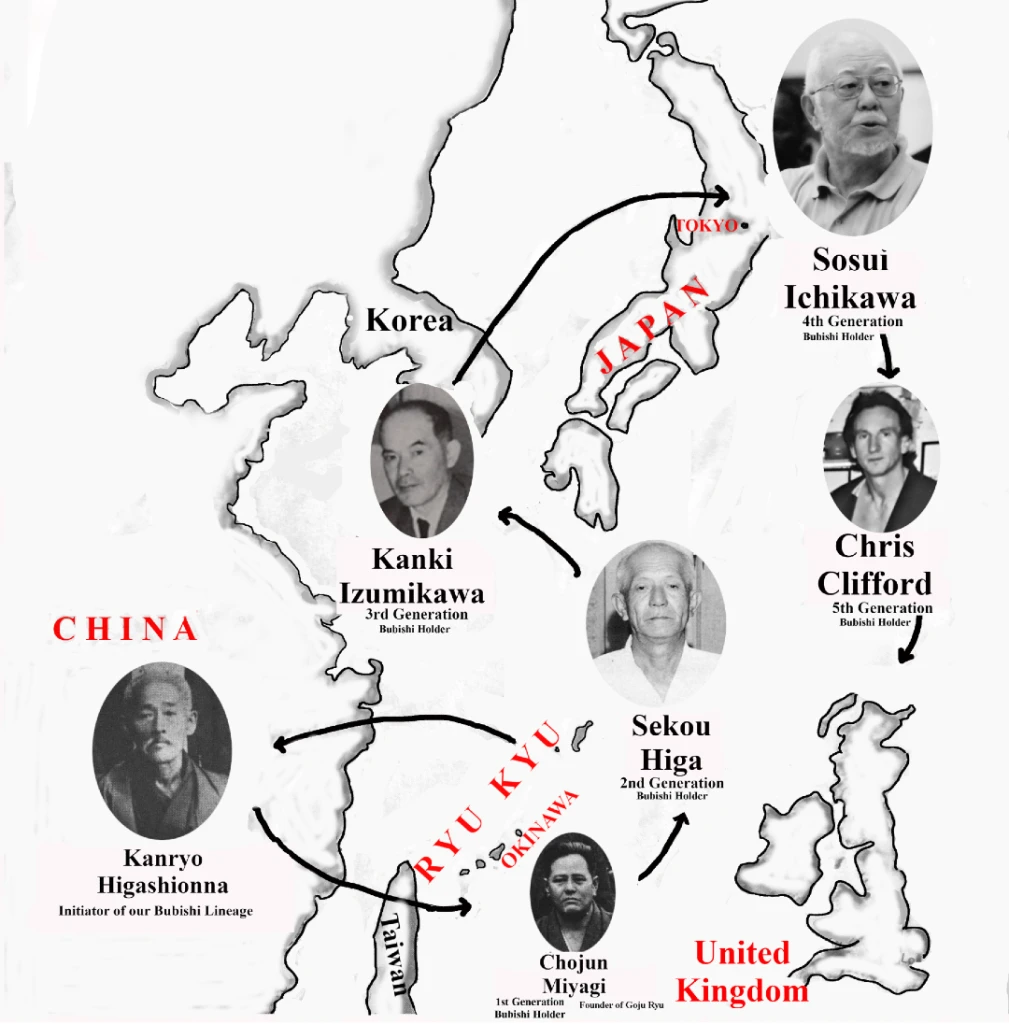masters by name
Taken from other historical documents and sources each of which have their own interpretation of history.

Kanryu Higashiona (Higaonna)
1853 – 1915
Higashionna Kanryo began training at martial arts in Naha, Okinawa at a very early age. In 1873 he travelled to Fuzhou, China where he studied kung fu and other Chinese systems under Ryu Ryuko who was the founder of Whooping Crane Kung Fu.
He returned to Okinawa in 1881 and brought back katas Sanchin, Seisan, Sanseiru and Pechurin (Superinpai). Around 1902 he began teaching publically. His martial arts was named Naha-Te. His first student was Juhatsu Kyoda. Chojun Miyagi and Seiko Higa also began training with him.
After Higashionna fell ill he was cared for by Chojun Miyagi. He died in 1915 aged 63. Miyagi inherited Higashionna’s Naha-Te and went on to develop Goju Ryu. Kyoda created Tou’on Ryu. Seiko Higa continued training with Miyagi but was never a full disciple, the two being close friends but with strong differences of opinion about the future development of martial arts.
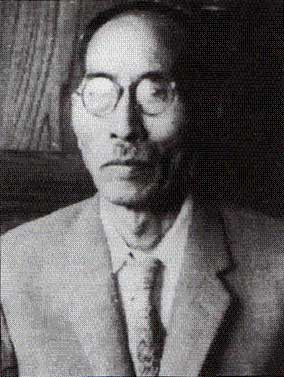
Juhatsu Kyoda
1887–1968
Entered the dojo of Higaonna in 1902 (1 month before Miyagi) and continued to study with him until Higionna’s death in 1915.
Among his students was Kanki Izumikawa.
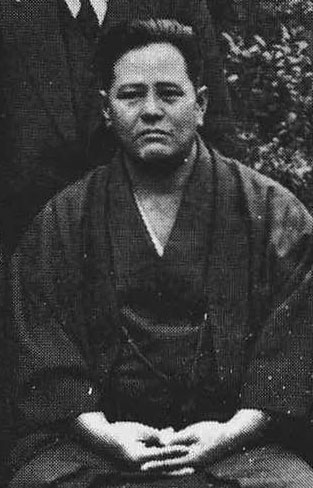
Chojun Miyagi
1888- 1953
1st Generation BUBISHI holder.
As a young man Chojun Miyagi entered the Dojo of Kanryu Higashiona in 1902. He stayed with his Master until his master died in 1915.
Because of his families wealth, Chojun Miyagi would invite his Master, Kanryu Higashiona, over to his house to teach him and offer dinner to his Master.
Chojun Miyagi returned to China and studied kung Fu (possibly Shaolin Kung Fu) like his Master. He wanted Karate to be spread across the world. He is most famous for standardised some Kata and created a more military system that was taught in schools, to the police, and later to the American Soldiers after the war. It was Chojun Miyagi that named the style of Karate in 1928 Goju-Ryu (Hard-Soft) taking the name from the ancient manuscript he teacher retuened from China with, the Bubishi.
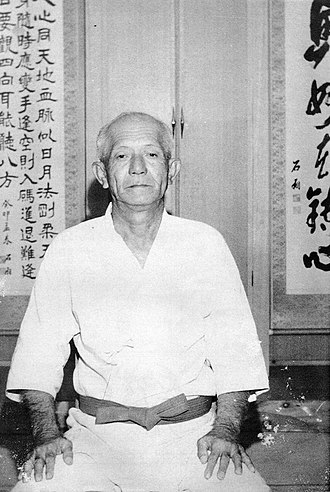
Seiko Higa
1898 -1966
2nd Generation BUBISHI holder.
Seiko Higa began training Naha-Te with Kanryo Higashionna at 13 years of age until his teacher died 4 years later. Higa then continued his training with Chojun Miyagi. After the death of Miyagi in 1953 there is doubt over which of his senior disciples were to become offical successor. However we know that Myiyagi’s son passed the Bubishi which Higashionna had given to Miyagi onto Seiko Higa. Higa stepped in as a temporary successor.
Although a student of Miyagi and having the foundations of Goju Ryu. Higa was not satisfied with the Miyagi training system. He took several trips to China to learn softer and more technical martial arts. He studied Tai Chi Chuan and Pa Chi CHuan and infused these forms into his Goju Ryu karate.
(Pa Chi Chuan has been described as – Eight Ultimate Fist Style has contributed major structural elements to many other Kung-Fu systems. Its is beleived by some that it was originated to develop such extreme striking power that a highly trained fighter could punch right through the different types of heavy bamboo body armor worn by troops of various emperors.)
Two of Higas best studens were Seiichi Akimene and Kanki Izumikawa, and with them he consolidated his system of training and added katas of Chinese origin including Naihanchi. He introducted many changes to the Goju Ryu system developed by Miyagi. One of the most important changes was to finish every kata with Nage Waza techniques from Aikido.
It seems that Higa and his students were totally independant from Miyagi. Higa generally developed his karate to be more useful and effective for smaller people against stronger adversaries. He also sought a better balance of Go and Ju. Tensho kata was generally considered by others to be excessively soft in the Goju system by Higa placed more importance on Tensho than Sanchin.
Miyagi allowed Higa to apply his own approaches to karate and awarded him the only 5th Dan award by him.

Kanki Izumikawa
1908 – 1967
3rd Generation BUBISHI holder.
Born April 16th 1908 in Okinawa to a samurai family, Kanki Izumikawa began training at 8 years of age. His first teacher was his grandfather, Kanchu Izumikawa, a senior student of Soken Matsumura, a master of Shurite in Okinawa.
In 1923, at age 15, he began training under Kyatsu Kyoda, who was a student of Kanryo Higashionna. He also studied under Chojun Miyagi. Then in 1928 at 26 years of age he began training under Seiko Higa. In 1938 he migrated to Tokyo Japan and opened his dojo which today is named Senbukai. He was the first instructor of Goju Ryu in Japan and his dojo is the oldest Goju Ryu dojo in the world. He was also a Shihan in kubudo (weapons).
After the 2nd World War Izumikawa taught Goju Ryu to American soldiers at the Haneda air force base. This led to Goju Ryu karate entering the USA, and spreading around the world.
Kanki Izumikawa was, like his teacher Seiko Higa, a very small man and was also devoted to developing the art of karate so that it could be used successfully against larger, stronger opponents like the American soldiers. His preferred kata was Tensho, which he combined with Tenshin (fast footwork and angles).. He also studied and further developed shoutei kumite (infight techniques) and created the technique of the unique approaching offense and defense kumite style which is clearly evidenced in some Senbukan lineage dojos.
Seiko Higa received Chojun Miyagi’s Bubishi after Miyagi died and it is the oldest surviving copy of the original Bubishi in the world. In 1934 Seiko Higa passed Bubishi, the transmission to Kanki Izumikawa making him the formal successor of Goju Ryu. Before Dan grades and titles were introduced the Bubishi was used as a teacher’s licence (menkyo kaiden) and evidence of true succession.
In 1942 Kanki Izumikawa received the ‘Renshi” title from the Nihon Butoku Kai (Japan traditional martial art association) and received the title of “Hanshi” (10th dan) in 1957.
Kanki Izumikawa’s best and number one student was Sosui Ichikawa. (Sosui Kan).
Kanki Izumikawa died in 1967 aged 59 years.
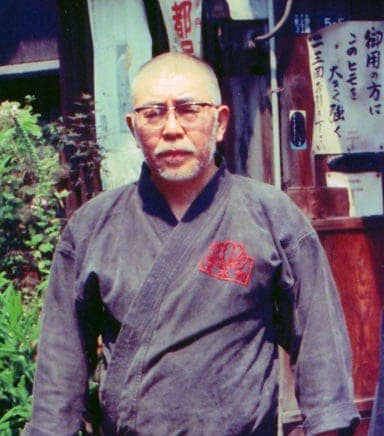
Sosui Ichikawa
4th Generation BUBISHI holder.
Sosui Ichikawa(素水 市川 : August 29, 1924―March 7, 2005) was Japanese martial artist born in Ueno, Tokyo, Japan who was the 4th Soke or head of the Zen Nihon Goju-Ryu karate-do Renmei or league (全日本剛柔流空手道連盟) and founder of the Sosuikan(素水館). He would teach Goju-Ryu karate while still doing his research and development. Ichikawa’s studies were often focused on the Bubishi (武備志) and would ultimately come to write his text, the Koshu-do (交手道). Sosui Ichikawa was accepted as Hanshi (範士) Judan (十段 or 10th dan) in 1983 by the Okinawa Karate-Do Renmei or league.
Ichikawa liked karate and art. At one point, he chose to purse one and devote himself entirely to it, making his decision towards the learning of karate. With his commitment and dedication to karate-do, Ichikawa continued looking for a suitable instructor to train with, and eventually heard of a dojo in Kawasaki that train by Kanki Izumikawa (寛喜 泉川) from Okinawa; thus, Ichikawa decided to go to Kawasaki to see this instructor for himself. He requested to enter the organization immediately after he arrived, but before an answer was given, one of the senior students challenged Ichikawa to a fight. Ichikawa was able to defeat him in their sparring match. With that he was admitted as Kanki Izumikawa’s student. Izumikawa was a top student of Seko Higa (世幸 比嘉) who trained directly with Naha-te master Kanryo Higashionna (寛量 東恩納) and then founder of Goju-Ryu Karate-do Chojun Miyagi (長順 宮城).
Ichikawa devoted more than a decade studying under Kanki Izumikawa. In 1951, Ichikawa was authorized to open his dojo, which he called Sosuikan (素水館) after his first name. Ichikawa grew the numbers of students within a brief time when he first began teaching; therfore, classes had to be temporarily taught in nearby park. Sosui would travel back and fourth from Tokyo to Kawasaki to continue his training with Izumikawa. Ichikawa studied obsessively and dedicated himself to mastering karate. He did not stop until he had fully understood a technique. Sosui was very tall for a Japanese man (6”feet tall); he used his big frame to overpower his rivals and was known as the Senbukan’s (泉武館) fiercest fighter. Kanki Izumikawa finally gave him 6th dan and gave him the Bubishi (武備志) with Izumikawa’s hand print to recognize him as the formal successor.
Sosui Ichikawa would teach the Goju-Ryu learned from Izumikawa at the Sosuikan (素水館) dojo while still doing his own research and development. Ichikawa’s Goju-Ryu evolved into his style over time. The studies were focused on the Bubishi (武備志) which is regarded as one of the most important texts in Goju-Ryu and karate. Sosui Ichikawa also emphasized the importance of Kumite in comprehending the essence of Goju-Ryu. Ichikawa would ultimately come to write his text, the Koshu-do (交手道), which was only handed to the most senior students, and it represented the culmination of his lifetime of study. The Koshudo is considered to be extension of the Bubishi. The Bubishi with Ichikawa’s handprint was issued to those who had mastered the whole system and were recognized as style’s successors, usually around 6th dan. The study of the Bubishi was regarded as extremely important so much so that in really, sometimes the successors refer to themselves as the Bubishi lineage
The Okinawa Karate-Do Renmei or league accepted Sosui Ichikawa as Hanshi (範士), Judan (十段) or 10th dan in 1983 with Yuchoku Higa (佑直 比嘉) issuing the certificate. Yuchoku Higa was one of Ichikawa’s few confidantes. Later Ichikawa founded the all-Japan Goju-Ryu Karate-Do Renmei or league. Ichikawa’s teachings stressed the notion that a smaller, weaker individual should be able to defeat a bigger, more powerful one. Ichikawa was also a strict perfectionist. He believed that even the slightest error in technique could be the difference between life and death. Ichikawa sensei also studied and practiced other styles, including Daito-Ryu Jujutsu (大東流柔術) and Judo (柔道), and held dan ranks in both. Due to expertise in martial arts, other masters from other styles such as Ninjitsu instructors Masaaki Hatsumi (良昭 初美), Okinawan Goju Instructor Meitoku Yagi (明徳 八木) and Shoto-kan (松濤館) instructor Hirokazu Kanazawa(弘和金澤) would go to Sosuikan to discuss concepts. As a result of his research, he expanded beyond Seko Higa (世幸 比嘉)lineage of Goju-Ryu and created many of unique techniques and concepts.
Despite his lack of international recognition Ichikawa was regarded by other masters as a great practitioner of Goju Ryu in mainland Japan. His senior students are among the few instructors who continue to practice the traditional ways of Goju-Ryu karate on the mainland Japan and only Chris Clifford in the UK. Since the Ichikawa school never wanted fame, their members are small. Ichikawa was himself was also picky about who he taught.
Sosui Ichikawa died in 2005. His resting place is at Takashima-daira Cemetery in Misono.
Hisao Ono, 7th Dan Sosuikan Secretary on August 31, 2022


Christophor Clifford
Born 1951
5th Generation BUBISHI holder.
Born in Peckham, South London, in 1951. my parents enrolled me into the Lynn A.C. Boxing Club while attending Junior School.
My introduction to karate came at the age of 15, when I joined a family friend, Barry Evens at the Upland Tavern, who was teaching Kyokushin kai karate. After joining the school, I soon came to realise more often than not, the bigger, heavier, stronger student would gain victory over the smaller weaker students. Feeling there must be more he decided his search must continue.
Just once in a lifetime one should embrace fate.
In 1972 whilst on holiday, I met Hiroshi Endo, a karate student of the late Grand Master Ichikawa Sosui or Goju Ryu Karate Do. Seeing him practice that day my heart told me, if Hiroshi Endo would accept me as a student my journey would begin. Hiroshi Endo was a practicing Acupuncture/Shiatsu therapist.
Endo contacted his master, Ichikawa Sosui, who gave his blessing for Hiroshi Endo Sensei to mentor me until I travelled to Japan to meet his Master. My journey had begun.
I studied Acupuncture and Shiatsu as Endo Sensei expressed its importance in the deeper understanding of his teachers Goju Ryu. I spent five years of dedicated study and practice with Endo Sensei.
During these 5 years, Endo Sensei had to return to Japan for a few months. Endo Sensei advised me to look for a Goju School while he was gone. He emphasised that it would not be the same but the experience of kumite would be good for me.
I contacted my local Goju-Kai club and met Sensei Brian Waites, who had studied karate in Japan and reached the level of 3rd Dan. Although very different karate, it was still to be a great opportunity. Sensei Brian was very good technically and he was extremely strong as he was also interested in weightlifting. I practiced karate and weightlifting with Brian Sensei, over a short time I gained weight and strength which was then something I felt I needed. I also studied daily what Endo Sensei had taught me. Brian Sensei assisted Endo Sensei to return to the UK which enabled me to continue my practice with my original mentor.
First visiting to Japan in 1977, Endo Sensei introduced me to Master Ichikawa Sosui. A most profound man, this was a truly amazing life-changing experience. I was now a disciple to his Master; I followed his way of studying karate and traveled to Grandmaster Ichikawa Sosui whenever I could. My teacher emphasised the practice of Kumite would lead to the true understanding of kata., in 1978 I opened my own Dojo in South London. In 1992 I received ‘Bubishi’ and other documents containing amongst other things the Koshudo along with Grand Master Ichikawa’s hand seal authorising my ‘teachers’ license’ of Goju Ryu Karate Do raising to the 7th level of my studies in 2002.
Continuing my studies under the Grand Master Ichikawa Sosui visiting him as much as 5 times in a year until his sad passing on March 7th 2005. Today I continue my research in to unraveling the treasure trove of documents and letters left to me by my Master, searching for the truth, unlocking the mysteries of his noble art of Goju Ryu Karate Do.
